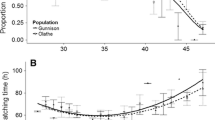Abstract
Group-living in animal populations has many possible ecological and evolutionary explanations, including predator evasion and feeding facilitation. In insects, the thermal balance of solitary and gregarious larvae is likely to differ and may thus have important ecological consequences. The abilities of the larvae of four species of nettle-feeding nymphalid butterflies to thermoregulate were quantified in the field. Larval surface body temperatures of the gregarious Aglais urticae (small tortoiseshell) and Inachis io (peacock) and the solitary Polygonia c-album (comma) and Vanessa atalanta (red admiral) were measured for each instar, in both sunny and overcast conditions, over a seasonal range of temperatures. The results suggested two distinct larval thermal strategies. In the presence of direct sunlight, the exposed gregarious larvae of A. urticae and I. io regulated body temperatures at 32.5 and 31.5°C, respectively, while the temperatures of concealed larvae of P. c-album and V. atalanta were largely dependent on ambient temperatures. In the sun, the range of body temperatures recorded for A. urticae and I. io larvae was fairly narrow relative to ambient temperatures. This suggests a high degree of thermal control in these species. Modal body temperatures coincided with the temperature at which development rate is maximal. Regardless of whether changes in thermoregulation are a cause or consequence of the evolution of gregariousness, the combination of behavioural thermoregulation and gregariousness in larval insects has important implications for voltinism patterns and range extension (via increased development rates). Distributional responses of gregarious and solitary larvae to climatic warming may differ as a result of changes in cloud cover as well as changes in temperature.
Similar content being viewed by others
Author information
Authors and Affiliations
Additional information
Received: 14 December 1998 / Accepted: 23 August 1999
Rights and permissions
About this article
Cite this article
Bryant, S., Thomas, C. & Bale, J. Thermal ecology of gregarious and solitary nettle-feeding nymphalid butterfly larvae. Oecologia 122, 1–10 (2000). https://doi.org/10.1007/PL00008825
Issue Date:
DOI: https://doi.org/10.1007/PL00008825



